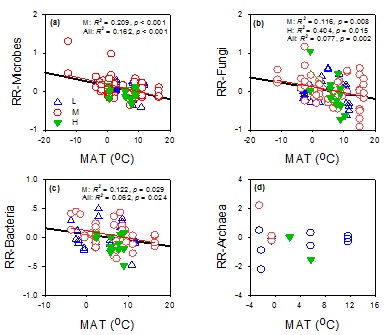The global mean air temperature has increased 0.6 oC during the past 100 years. It is also projected that there might be another increase of 1.4-5.8 oC during the end of this century. The rising temperatures can impact soil carbon cycles, potentially causing both positive and negative feedbacks to future climates. However, it is still unclear that how soil carbon cycles will respond to global climate change.
An important ongoing endeavor in current global change ecology and biology is incorporating microbial responses into Earth system models, as microbes have been highlighted as one of main unknowns controlling the fate and turnover of soil organic matter. Modeling studies predicted that climate warming would stimulate microbial decomposition of soil organic matte, representing an important positive feedback loop. However, there remains large uncertainties, one of the possible mechanisms is that how microbial abundance responds to global climate change.
In this study, Dr. CHEN Ji from the Institute of Earth Environment, Chinese Academy of Sciences, together with professor LUO Yiqi from the University of Oklahoma and professor ZHOU Xuhui from the East China Normal unversity conduct a meta-analysis of previous publications on the responses of microbial abundances to warming treatments. They finally selected 64 highly related published papers from more than 1000 published papers. These 64 published papers include results from different measurement methods (PLFA, chloroform fumigation, qPCR, and RNA), vegetation types (forest, grassland, wetland, and tundra), soil types (arenosols, histosols, cambisols, luvisols, and podzols), warming methods (open top chamber, infraded heater, heating cables, and curtains), and warming time (day, night, growing season, and non-growing season).We collect all data from these 64 papers, If data were presented graphically, we used Engauge Digitizer 4.1 (http://digitizer.sourceforge.net) to digitize the data. We then re-analyzed these data using meta-analysis. Our results show that stronger warming effects on microbial abundance in colder regions, and the response ratios of microbial abundances are closely related to the response ratio of soil respiration. Our findings therefore indicate that the large quantities of C stored in colder regions are likely to be more vulnerable to climate warming than the soil C stored in other warmer regions.

Fig. 1 Stronger warming effects on microbial abundance in colder regions (Image by CHEN Ji)
Publication: Chen J, Luo Y, Xia J, Jiang L, Zhou X, Lu M, Liang J, Shi Z, Shelton S, Cao J. 2015. Stronger warming effects on microbial abundances in colder regions. Scientific Reports 5, 18032. DOI: 10.1038/srep18032.
Contact:CHEN Ji
State Key Laboratory of Loess and Quaternary Geology (SKLLQG), and Key Laboratory of Aerosol Chemistry and
Physics, Institute of Earth Environment, Chinese Academy of Sciences,
Email: chenji@ieecas.cn
 © 2015 Institute of Earth Environment,CAS
© 2015 Institute of Earth Environment,CAS Address:No. 97 Yanxiang Road, Xi'an 710061, Shaanxi, China

 Location :
Location :